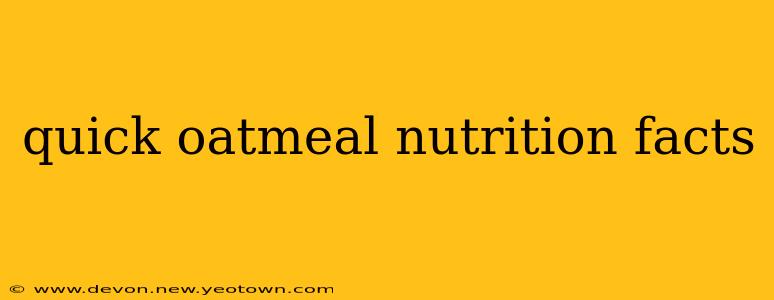Quick oatmeal, that familiar breakfast staple, is more than just a convenient morning meal. It's a nutritional powerhouse packed with benefits that can fuel your day. But just how nutritious is it, really? Let's delve into the fascinating world of quick oats and uncover the secrets behind their nutritional profile.
Imagine this: a chilly morning, the aroma of warm oatmeal filling your kitchen, a comforting bowl of creamy goodness waiting to be devoured. That's the magic of quick oats – simple pleasure with significant health advantages. But beyond the comforting warmth, lies a surprisingly diverse nutritional landscape.
What are the main nutritional benefits of quick oats?
Quick oats are a whole-grain powerhouse, boasting a wealth of vitamins, minerals, and fiber. They're an excellent source of soluble fiber, particularly beta-glucan, which plays a crucial role in lowering cholesterol levels and regulating blood sugar. This soluble fiber also contributes to that satisfying feeling of fullness, helping you manage your weight and stave off those mid-morning hunger pangs.
Beyond fiber, quick oats provide a decent amount of essential minerals like magnesium, manganese, and iron, crucial for energy production, bone health, and oxygen transport throughout your body. They also offer a good dose of B vitamins, vital for maintaining a healthy nervous system and converting food into energy.
How many calories are in a serving of quick oatmeal?
The calorie count in quick oatmeal varies depending on the serving size and any added ingredients. A typical ½ cup serving of dry quick oats contains around 150 calories. However, this number can quickly escalate with the addition of sugar, milk, fruits, nuts, or sweeteners. Remember that customizing your oatmeal allows you to fine-tune its nutritional profile to suit your dietary needs and preferences.
Is quick oatmeal good for weight loss?
Yes, quick oatmeal can be a valuable asset in your weight loss journey. The high fiber content promotes satiety, keeping you feeling full for longer and reducing overall calorie intake. This helps in curbing those unhealthy snacking habits that often derail weight loss efforts. Moreover, the slow release of energy from complex carbohydrates prevents sudden blood sugar spikes, minimizing energy crashes and preventing those tempting cravings.
What are the differences between quick oats, rolled oats, and steel-cut oats?
The key difference lies in the processing. Steel-cut oats are the least processed, retaining their whole grain structure and offering a chewier texture and longer cooking time. Rolled oats are steam-rolled and flattened, resulting in a quicker cooking time than steel-cut oats. Quick oats undergo further processing, making them even faster to prepare but slightly less nutritious compared to rolled and steel-cut oats, as some nutrients may be lost during the extra processing stages. The nutritional differences, however, are relatively minor.
Are there any downsides to eating quick oatmeal?
While quick oats offer many benefits, it's important to be mindful of potential downsides. Some individuals may experience gas or bloating due to the high fiber content. Additionally, processed quick oats often contain added sugars or preservatives, so choosing plain, unflavored varieties is crucial to maximize the nutritional benefits and minimize added sugars.
Quick Oatmeal: A Versatile Breakfast Champion
From a simple bowl of warm oats to a gourmet creation brimming with fruits, nuts, and spices, quick oatmeal offers unparalleled versatility. It’s a breakfast champion, adaptable to any taste and dietary preference, a blank canvas for culinary creativity. Embrace the power of this humble grain and enjoy the delicious journey to a healthier, more energized you!

